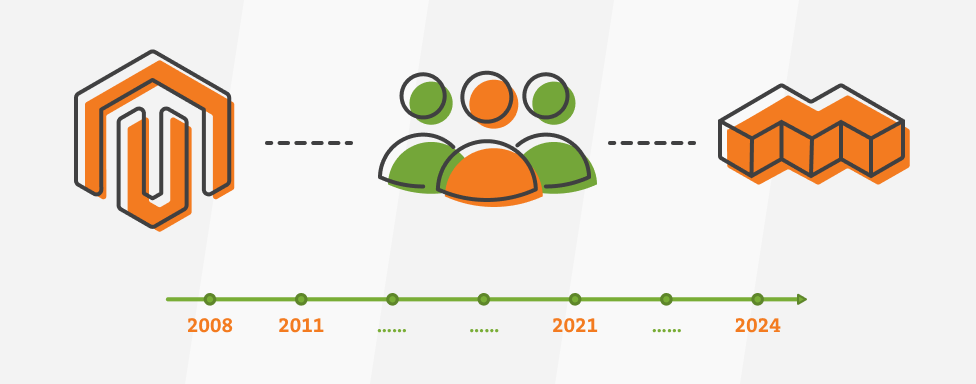Anyone who is in the Magento world knows the open-source eCommerce platform has had an interesting journey – both tumultuous and exciting – through its almost two decade long existence. Not only have the reports of its death been greatly exaggerated, it has a thriving community around it that is furthering the development of the platform in new and exciting ways.
To understand how this community developed and where Magento is heading under its guidance, it’s important to first understand how and why Magento came to be and what circumstances allowed its community to grow.
Magento: a New Hope for eCommerce
Spearheaded by Varien Inc, Magento 1.0 was launched as an open-source eCommerce platform in March 2008, driven by a need for a robust, flexible, open-source solution in the eCommerce world.
What distinguished Magento from its competitors were its innovative features. With powerful customization options, ability to scale and adapt to businesses of various sizes, powerful SEO tools, and a user-friendly administrative interface, Magento quickly became the preferred choice for businesses looking for a cutting-edge, scalable, and feature-rich eCommerce solution.
This was a significant milestone for the world of eCommerce, giving merchants of all sizes the possibility to enter the online marketplace. By November 2008, Magento already had 500,000 downloads, making it one of the fastest growing eCommerce platforms on the market.
The open-source nature of the platform was another game-changer. It encouraged innovation and competition, inviting developers around the world to contribute to the platform, building upon its capabilities and expanding its features.
A strong community started to build around Magento, and the first Magento Imagine Conference was held in 2011 in Los Angeles. In the years to come the non-profit Magento Association has assisted in organizing the Meet Magento events around the world, driving networking and collaboration. We even organized a few in our hometown of Osijek in Croatia.
November 2015 was the next momentous moment for Magento with the launch of Magento 2.0. This was a significant point in Magento’s history that delivered improved performance, enhanced stability and streamlined checkout processes, along with a responsive design framework, a factor that was increasingly important with the growing mobile market.
Adobe Strikes Back
Magento has changed hands a few times. Its original owner Varien – who had in 2010 rebranded the company’s name to Magento Inc. – announced in 2011 eBay had made an investment in Magento worth 49% ownership share of the company. Later in June 2011, eBay acquired the entire company.
As the then-owner of PayPal, eBay integrated PayPal directly into the Magento platform, but the split of PayPal from eBay in 2015 resulted in Magento being spun out as an independent company, funded by the new owner Permira.
A significant change came into place in 2016 with the introduction of the Magento Enterprise Edition as a platform as a service. The Enterprise Edition had the same core as source as the Magento Community Edition with the key difference being that it was intended for large businesses that require technical support for installation, usage, configuration and troubleshooting.
In 2017 the two editions were renamed Magento Open Source – as we know it today – and Magento Enterprise. Finally, in 2018 Magento was acquired by Adobe, and under Adobe’s leadership, Magento Enterprise was renamed to Adobe Commerce and became the primary beneficiary of Adobe’s support.
With this shift in focus, Magento Open Source was left to the grace of its community, with the only support received being that in the form of security updates, bug fixes and minor improvements. Any other features, now crafted as SaaS-based addons with little openly accessible code, were intended exclusive for Adobe Commerce.
Without any public roadmap for Magento Open Source, the platform was, in essence, left without a home.
Mage-OS: Return of Magento
With this uncertain limbo state Magento Open Source had found itself in, the community built up around the platform decided to take matters into their own hands.
In 2021, Mage-OS was announced as a community-driven fork under the umbrella of the Mage-OS Association focused on continuing the development and support of the Magento platform. Providing a collaborative environment where developers can contribute to the Magento codebase, share knowledge and create new features and extensions, Mage-OS seeks to promote the growth and sustainability of the platform for the future.
The first release of Mage-OS was in October 2023 as an upstream compatible, lightweight composition of Magento Open Source packages intended to be compatible with all existing Magento 2 extensions and integrations to the greatest extent possible.
Other initiatives have sprung out of the Magento community, such as the Hyvä frontend theme, intended to replace Magento’s outdated technologies and provide it with a modern, lightweight frontend solution.
Magento’s Present and the Future
The efforts of the Magento’s community bore fruit. At the Meet Magento UK 2024 conference, it was announced that Magento was finally receiving a new home with the launch of its brand new marketing site, as a result of a collaboration between the Magento Association and Mage-OS.
After an uncertain period, it appears Magento’s future is looking bright. We are confident these new endeavours will lead to many new advancements and projects and are excited more than ever to be part of Magento’s community.



